#greater one-horned rhinoceros
Text
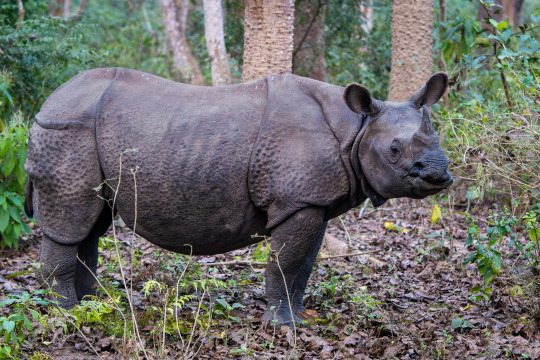
Greater one-horned rhinoceros Rhinoceros unicornis
Observed by shanes, CC BY-NC
19 notes
·
View notes
Text

Greater One-Horned Rhino (Rhinoceros unicornis)
taken at the Denver Zoo in Denver, Colorado
status: vulnerable
These big animals are also known as the Indian Rhino but an easy way to identify them is by their single horn that can grow to be 8 to 25 inches in length!
#Greater One-Horned Rhino#Greater One Horned Rhino#Indian Rhino#Rhinoceros unicornis#animal#wildlife#denver zoo#denver#zoo#colorado#photo#photography#canon#canon 6d mark ii
11 notes
·
View notes
Text
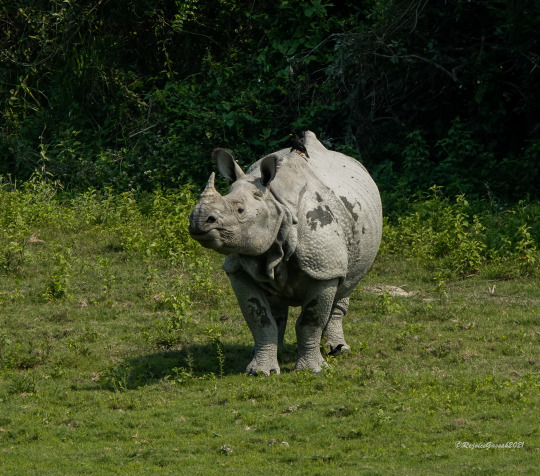
Meet the greater one-horned rhino (Rhinoceros unicornis). This mighty mammal can weigh as much as 6,000 lbs (2,721 kg)! It’s distinguished by its single horn, which can reach lengths of 25 in (63 cm). Despite its size, this herbivore can move quickly, charging at speeds of up to 25 mph (40 km/h). This semi-aquatic animal prefers to live near water and tends to inhabit swamps, riversides, and forests in parts of Asia, including Nepal and India.
Photo: rejoicegassah, CC BY 4.0, iNaturalist
#nature#animals#rhino#did you know#fact of the day#greater one horned rhino#cool animals#animal kingdom#mammals
475 notes
·
View notes
Text

The Indian Javan Rhinoceros was often mistaken for the Greater one-horned Rhinoceros due to their coexistence in the 19th century.
This can't happen to you. Join the club Here to learn more about animals.
By the way, this is the only existing illustration of this animal.
#Indian Javan Rhinoceros#javan rhinoceros#Rhinoceros#rhino#rinoceronte#conservation#extinction#exotic animals#scientific illustration#illustration#wild animals#artist on tumblr#mammals#wildlife
35 notes
·
View notes
Note
we HAVE unicorns, they're all different levels of engagement

which unicorn is your favorite?
How quickly I forget the humble unicorn...
Gotta go with the greater one-horn rhino/Indian rhino (it's even called Rhinoceros unicornis) I like their ear shape, and I like when a mammal is semi-aquatic.

silly guy
#fortunately the Indian rhino isn't endangered#also that pic of the Sumatran rhinoceros has the brush in front of it- I thought the poor thing just had a dip#like a cartoon character getting squished in one part of their body#personal pig#chimeramoth
9 notes
·
View notes
Text

Chapter 4. Environment
The only way to save the planet
When it comes to protecting the environment, nearly any social system would be better than the one we have now. Capitalism is the first social arrangement in human history to endanger the survival of our species and life on earth in general. Capitalism provides incentives to exploit and destroy nature, and creates an atomized society that is incapable of protecting the environment. Under capitalism, ecocide is literally a right. Environmental protections are “trade barriers”; preventing a corporation from clear-cutting land it has purchased is a violation of private property and free enterprise. Companies are allowed to make millions of tons of plastic, most of it for throwaway packaging, despite the fact that they have no plan for disposing of it and not even any idea what will happen with it all; plastic does not decompose, so plastic trash is filling up the ocean and appearing in the bodies of marine creatures, and it may last millions of years. To save endangered rhinoceros from poachers, game wardens have started sawing off their valuable horns; but the poachers are killing them anyway because once they are extinct, the value of the few remaining bits of rhinoceros ivory will go through the roof.
And despite all this, universities have the audacity to indoctrinate students to believe that a communal society would be incapable of protecting the environment because of the so-called tragedy of the commons. This myth is often explained thus: imagine a society of sheepherders owns the grazing land in common. They benefit collectively if each grazes a smaller number of sheep, because the pasture stays fertile, but any one of them benefits individually if he overgrazes, because he will receive a greater share of the product — thus collective ownership supposedly leads to depletion of resources. The historical examples intended to corroborate this theory are generally drawn from colonial and postcolonial situations in which oppressed people, whose traditional forms of organization and stewardship have been undermined, are crowded onto marginal land, with predictable results. The sheepherding scenario assumes a situation that is extremely rare in human history: a collective comprised of atomized, competitive individuals who value personal wealth over social bonds and ecological health, and lack social arrangements or traditions that can guarantee sustainable, shared use.
Capitalism has already caused the biggest wave of extinctions to hit the planet since an asteroid collision killed off the dinosaurs. To prevent global climate change from bringing about total ecological collapse, and stop pollution and overpopulation from killing off most of the planet’s mammals, birds, amphibians, and marine life, we have to abolish capitalism, hopefully within the next few decades. Human-caused extinctions have been apparent for at least a hundred years now. The greenhouse effect has been widely acknowledged for nearly two decades. The best that the reputed ingenuity of free enterprise has come up with is carbon trading, a ridiculous farce. Likewise, we cannot trust some world government to save the planet. A government’s first concern is always its own power, and it builds the base of this power upon economic relationships. The governing elite must maintain a privileged position, and that privilege depends on the exploitation of other people and of the environment.
Localized, egalitarian societies linked by global communication and awareness are the best chance for saving the environment. Self-sufficient, self-contained economies leave almost no carbon footprint. They don’t need petroleum to ship goods in and waste out, or huge amounts of electricity to power industrial complexes to produce goods for export. They must produce most of their energy themselves via solar, wind, biofuel, and similar technologies, and rely more on what can be done manually than on electrical appliances. Such societies pollute less because they have fewer incentives to mass production and lack the means to dump their byproducts on others’ land. In place of busy airports, traffic-clogged highways, and long commutes to work, we can imagine bicycles, buses, interregional trains, and sailboats. Likewise, populations will not spiral out of control, because women will be empowered to manage their fertility and the localized economy will make apparent the limited availability of resources.
An ecologically sustainable world would have to be anti-authoritarian, so no society could encroach on its neighbors to expand its resource base; and cooperative, so societies could band together in self-defense against a group developing imperialist tendencies. Most importantly, it would demand a common ecological ethos, so people would respect the environment rather than regarding it simply as raw material to exploit. We can begin building such a world now, by learning from ecologically sustainable indigenous societies, sabotaging and shaming polluters, spreading a love for nature and an awareness of our bioregions, and establishing projects that allow us to meet our needs for food, water, and energy locally.
#environmentalism#environment#solarpunk#anti colonialism#anarchism#daily posts#communism#anti capitalist#anti capitalism#late stage capitalism#anarchy#anarchists#libraries#leftism#social issues#economy#economics#climate change#anarchy works
8 notes
·
View notes
Photo

No rhinos were poached last year in the world's largest reserve for the endangered great one-horned rhinoceros, India's Assam state, in what authorities said was the first time since 1977.
Poachers killed more than 190 rhinos in Assam between 2000 and 2021 but none was killed last year, according to data shared by the Assam Police. According to IFAW, the greater one-horned rhino, also known as the Indian rhino, were once widespread across the entire northern region of India until they were decimated in the early 19th century due to the popularity of sport hunting. As a result, it is estimated that in 1908 there were only 12 rhinos left in Kaziranga, India. Thankfully, Assam, is now home to the world’s largest population of greater one-horned rhinos, with nearly 2,900 across the region today. Thanks to conservation efforts, the species has now doubled across north-eastern India. Source: World Animal News (link in bio)
#conservation #rhino #india https://www.instagram.com/p/CoH6aYer6n2/?igshid=NGJjMDIxMWI=
77 notes
·
View notes
Text
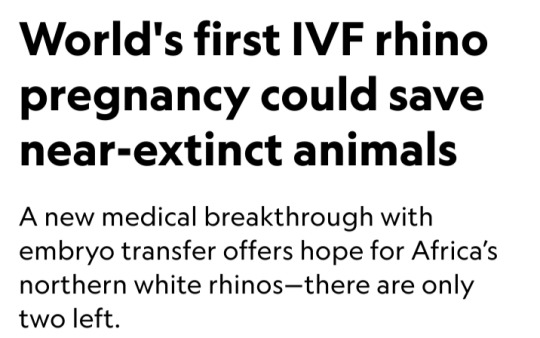

By Dina Fine Maron
January 24, 2024
Scientists have cleared a significant hurdle in the years-long effort to save Africa’s northern white rhinoceros from extinction with the first-ever rhino pregnancy using in vitro fertilization.
The lab-assisted pregnancy, which researchers will announce today, involved implanting a southern white rhino embryo in a surrogate mother named Curra.
The advance provides the essential “proof of concept” that this strategy could help other rhinos, says Jan Stejskal of the BioRescue project, the international group of scientists leading this research.
Curra died just a couple months into her 16-month pregnancy from an unrelated bacterial infection, Stejskal says.
However, the successful embryo transfer and early stages of pregnancy pave the way for next applying the technique to the critically endangered northern white rhino.
The process was documented exclusively by National Geographic for an upcoming Explorer special currently slated to air in 2025 on Nat Geo and Disney+.
BioRescue expects to soon implant a northern white rhino embryo into a southern white rhino surrogate mother.
The two subspecies are similar enough, according to the researchers, that the embryo will be likely to develop.
Eventually, this approach may also help other critically endangered rhinos, including the Asian Javan rhinoceros and the Sumatran rhinoceros, which each now number under 100 individuals, Stejskal says.
But the northern white rhino’s current situation is the most pressing by far.
There are no males left, and the only two remaining animals are both elderly females that live under armed guard on a reserve in a 700-acre enclosure in Kenya called Ol Pejeta Conservancy.
The boxy-jawed animals once roamed across central Africa, but in recent decades, their numbers have plummeted due to the overwhelming international demand for their horn, a substance used for unproved medicinal applications and carvings.
Made from the same substance as fingernails, rhino horn is in demand from all species, yet the northern white rhino has been particularly hard-hit.
"These rhinos look prehistoric, and they had survived for millions of years, but they couldn’t survive us,” says Ami Vitale, a National Geographic Explorer and photographer who has been documenting scientists’ efforts to help the animals since 2009.
“If there is some hope of recovery within the northern white rhino gene pool �� even though it’s a substantially smaller sample of what there was — we haven’t lost them,” says conservation ecologist David Balfour, who chairs the International Union for the Conservation of Nature’s African rhino specialist group.
Blueprints for rhino babies
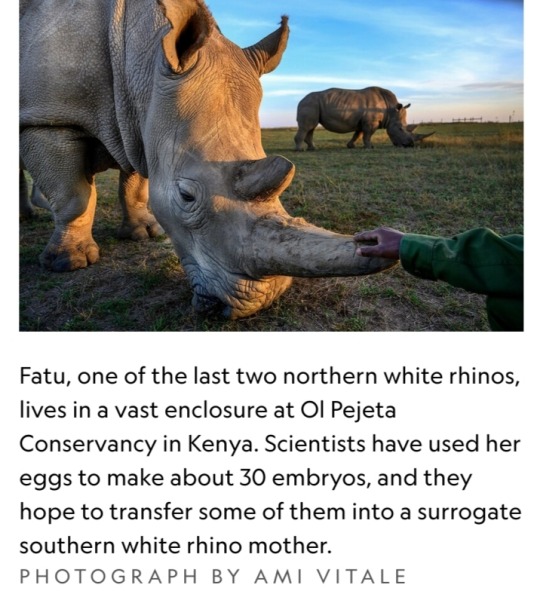
To stave off the animal’s disappearance, BioRescue has used preserved sperm from northern white rhinos and eggs removed from the younger of the two remaining females.
So far, they’ve created about 30 preserved embryos, says Thomas Hildebrandt, the head scientist of BioRescue and an expert in wildlife reproduction based at the Leibniz-Institute of Zoo and Wildlife Research in Berlin.
Eventually, the team plans to reintroduce northern white rhinos into the wild within their range countries.
“That’d be fantastic, but really, really far from now—decades from now,” says Stejskal.
Worldwide, there are five species of rhinoceros, and many are in trouble.
Across all of Africa, there are now only about 23,000 of the animals, and almost 17,000 of them are southern whites.
Then there are more than 6,000 black rhinos, which are slightly smaller animals whose three subspecies are critically endangered.
In Asia, beyond the critically endangered Javan and Sumatran rhinos, there’s also the greater one-horned rhino, whose numbers are increasing and currently are estimated to be around 2,000.
The BioRescue effort has experienced many setbacks, and even though the team now has frozen embryos, the clock is ticking.
The researchers intend to use southern white rhinos as surrogate moms for the northern white rhino embryos.
However, scientists want any northern white rhino calves to meet and learn from others of their kind, which means they need to be born before the two remaining females die.
“These animals learn behaviors — they don’t have them genetically hard-wired,” says Balfour, who’s not involved with the BioRescue work.
But birthing new animals in time will be a challenge.
“We’re really skating on the edge of what’s possible,” he says, “but it’s worth trying.”
Najin, the older female, will be 35 this year, and Fatu will be 24.
The animals, which were born in a zoo in the Czech Republic, are expected to live to about 40, says Stejskal, who also serves as director of international projects at the Safari Park Dvůr Králové, the zoo where the animals lived until they were brought to Kenya in 2009.
Impregnating a rhino
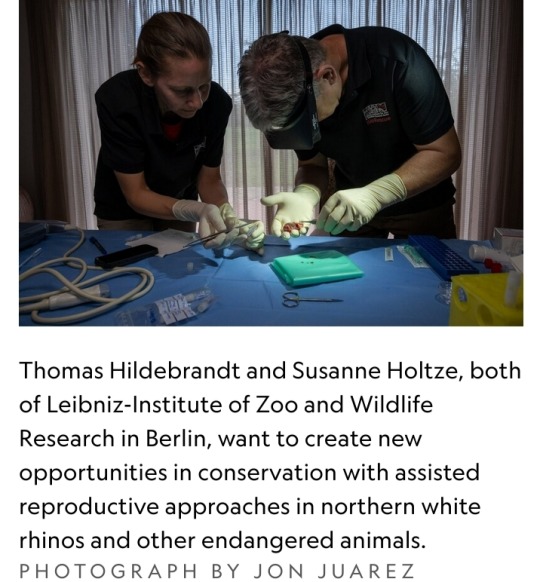
The next phase of BioRescue’s plan involves implanting one of their limited number of northern white rhino embryos into a southern white rhino surrogate mother — which the group plans to do within the next six months, Stejskal says.
They’ve identified the next surrogate mother and set up precautions to protect her from bacterial infections, including a new enclosure and protocols about disinfecting workers’ boots.
But now, they must wait until the female rhino is in estrus — the period when the animal is ready to mate — to implant the egg.
To identify that prime fertile time, they can’t readily perform regular ultrasounds at the conservancy as they might do in a zoo.
Instead, they have enlisted a rhino bull that has been sterilized to act as a “teaser” for the female, Hildebrandt says, adding that they must wait a few months to make sure that their recently sterilized male is truly free of residual sperm.
Once the animals are brought together, their couplings will alert conservancy staff that the timing is right for reproductive success.
The sex act is also important because it sets off an essential chain of events in the female’s body that boosts the chances of success when they surgically implant the embryo about a week later.
"There’s little chance the conservancy staff will miss the act. White rhinos typically mate for 90 minutes," Hildebrandt says.
What’s more, while mounted on the females, the males often use their temporary height to reach tasty plant snacks that are generally out of reach.
Boosting genetic diversity
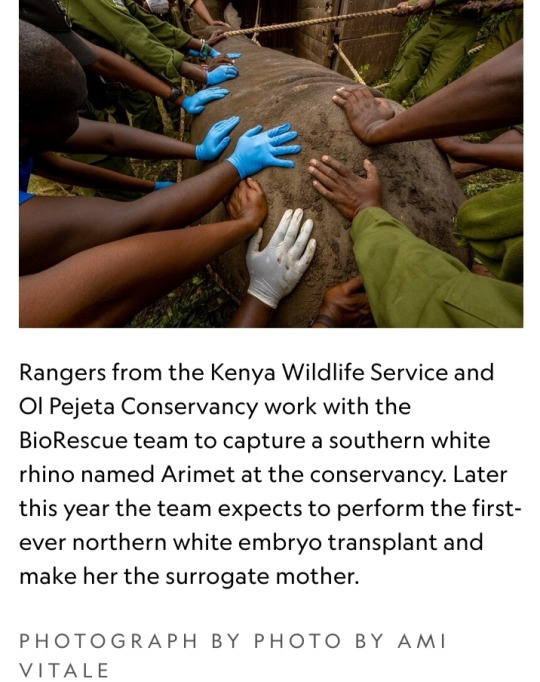
With so few northern white rhinos left, their genetic viability may seem uncertain.
But the BioRescue team points to southern white rhinos, whose numbers likely dropped to less than 100, and perhaps even as few as 20, due to hunting in the late 1800s.
Government protections and intense conservation strategies allowed them to bounce back, and now there are almost 17,000.
“They have sufficient diversity to cope with a wide range of conditions,” says Balfour.
Researchers don’t know exactly how many southern white rhinos existed a century ago, he says, but it’s clear that the animals came back from an incredibly low population count and that they now appear healthy.
Beyond their small collection of embryos, the BioRescue team hopes to expand the northern white rhino’s gene pool by drawing from an unconventional source — skin cells extracted from preserved tissue samples that are currently stored at zoos.
They aim to use stem cell techniques to reengineer those cells and develop them into sex cells, building off similar work in lab mice.
According to their plan, those lab-engineered sex cells would then be combined with natural sperm and eggs to make embryos, and from there, the embryos would be implanted into southern white rhino surrogate mothers.
Such stem cell reprogramming work has previously led to healthy offspring in lab mice, Hildebrandt says, but rhinos aren’t as well-studied and understood as mice, making this work significantly challenging.
A global effort
The northern white rhino revitalization venture has cost millions of dollars, supported by a range of public and private donors, including the German Federal Ministry of Education and Research.
Other partners on the effort include the Leibniz Institute for Zoo and Wildlife Research, the Czech Republic’s Safari Park, Kenya Wildlife Service, Ol Pejeta Conservancy, and also Katsuhiko Hayashi, a professor of genome biology at Osaka University in Japan who conducted the mouse stem cell research.
Building upon Hayashi’s stem cell techniques could ultimately bring the northern white rhino gene pool up to 12 animals — including eggs from eight females and the semen of four bulls, according to Stejskal.
An alternative approach to making more babies, like crossbreeding northern and southern white rhinos, would mean the resulting calves wouldn’t be genetically pure northern white rhinos, Hildebrandt notes.
The two subspecies look quite similar, but the northern version has subtle physical differences, including hairier ears and feet that are better suited to its swampy habitat.
The two animals also have different genes that may provide disease resiliency or other benefits, Hildebrandt says.
There are unknown potential differences in behavior and ecological impact when populating the area with southern white rhinos or cross-bred animals.
"The northern white rhino is on the brink of extinction really only due to human greed,” Stejskal says.
“We are in a situation where saving them is at our fingertips, so I think we have a responsibility to try.”
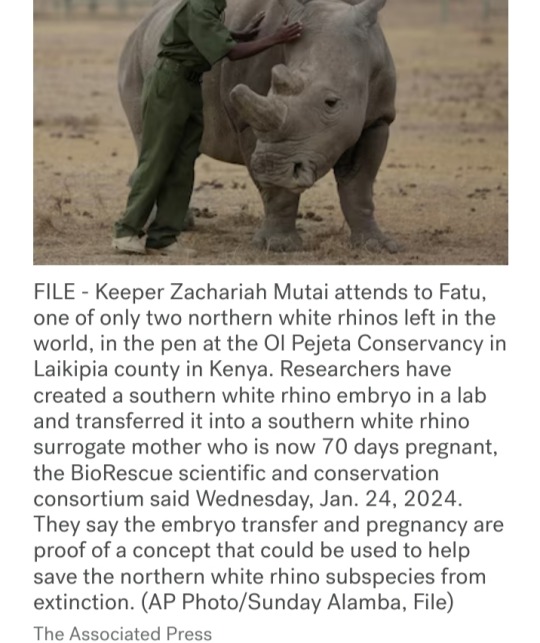
🩶🦏🩶
#northern white rhinoceros#rhino embryo transfer#in vitro fertilization#IVF#southern white rhinoceros#critically endangered animals#National Geographic#BioRescue#rhino horn#International Union for the Conservation of Nature#African rhino specialist group#Thomas Hildebrandt#German Federal Ministry of Education and Research#Leibniz Institute for Zoo and Wildlife Research#Kenya Wildlife Service#Ol Pejeta Conservancy#Katsuhiko Hayashi#genome biology#IVF rhino pregnancy
8 notes
·
View notes
Text
Anyway I'm gonna revisit the neuroscience tomorrow on the plane, right now I'm taking a break to go to ZOO (specifically the Tampa Zoo where I am informed they got a Greater One - Horned Indian rhinoceros).
I wanted to hit up the Belize zoo on my vacation but that wound up not happening, but this will be an excellent interim treet.
11 notes
·
View notes
Text
Hellish Beasts & How to Avoid Them
Feral Imp: Far more impulsive and cruel than their civilized counterparts, Feral Imps dwell in the wild places. Some are the size of men, though most are shorter and weaker. Their strength, however, is in sheer numbers and they will gleefully tear apart any poor soul they’ve piled onto.
Wretch: Not all sinners keep their minds intact. For some, the mere realization of where they are is enough to sever them from their humanity. Though most are cowardly creatures, they fight with reckless abandon and fiercely protect their hovels.
Hellsteed: Having as many breeds as living horses, Hellsteeds are the prized mounts of many greater demons. Larger, stronger, bolder and faster than their earthly cousins, they stampede across the plains in search of prey. Even when domesticated, taming one is a challenge to the death that few can win.
Dark Pegasus: Unlike Hellsteeds, a Dark Pegasus is a solitary creature that’s fiercely territorial over its hunting grounds. While they generally prefer hunting helpless prey, they will devour any challengers or would-be tamers. A man might bring a Hellsteed under control, but it takes an overlord’s willpower to earn a Pegasus’ loyalty.
Hellboar: Though many have been domesticated and made more tame, the occasional wild Hellboar can still be found. Like their terrestrial cousins, Hellboars are hardy and tenacious beasts with tusks capable of disemboweling a man. When gravely wounded, they fight even harder and will do anything to ensure their killer dies with them---such is their spite.
Warhound: Sometimes called “Feral Hellhounds” by the ignorant, Warhounds are bloodthirsty creatures with larger fangs and claws. Overlords and other demonic tyrants may take them as guard dogs, but their true purpose---what Satan Himself bred them for---is to be unleashed in battle to terrorize and rip enemies to shreds. Some breeds possess toxic or acidic drool, while others sport horns or bone-spikes on their backs.
Manticore: With a spiky tail and a cruel cunning, these winged lions are one of Hell’s greatest predators. Just one is enough of a match for several armed men, but an entire pride on the hunt is a grisly demise guaranteed. Some of the most powerful and merciless overlords have unleashed them in battle, though a Manticore is just as likely to feast on its “master” as it would his enemies.
Hellish Charger: Sporting three horns as sharp as steel and a hide stronger than iron, Chargers are a favored war-beasts among overlords and other demonic tyrants. Though they loosely resemble an Earth rhinoceros, they are the size of elephants and far more temperamental. Satan’s imps ride them into battle atop large platforms---though they can barely control them and riders are trained to hammer a spike into their skull when they go berserk.
Lava Drake: Wingless but no less deadly than dragons, Lava Drakes or “Salamanders” live in volcanic regions and in packs. Rather than breathing fire, they spit molten rock to both burrow their tunnels and melt their enemies. What you might think is a patch of solid ground in a fiery pool is likely the back of a basking Lava Drake.
Hydra: Lurking in the depths of Envy, Hydras are one of the greatest predators across Hell. Most have three serpentine heads and are capable of spitting venom, though accounts report some having seven heads and breathing ice. They swim swiftly and attack small vessels at sea, but they will hunt on land as well.
Red Dragon: Dwelling in the mountains, Red Dragons are one of the largest and strongest beasts in all of Hell. They typically hunt the lesser draconic species---drakes, amphitheres, wyrms and wyverns---in addition to Hellsteeds and Hellboars, but they will not abstain from devouring imps or sinners. Only one overlord has ever successfully tamed one of these dragons.
Black Dragon: Being the strongest and largest beast in Hell, the Black Dragon is thankfully very rare. Bred by Lucifer Himself and gifted to his greatest servants, they are terrors to behold which can turn whole armies to ash in a single breath. Unlike their cousins, however, there is intelligence behind their devastation.
5 notes
·
View notes
Note
Ctesias got his information while living in Persia. Unicorns ,or more likely, winged bulls, appear in reliefs at the ancient Persian capital of Persepolis in Iran.[8] Aristotle must be following Ctesias when he mentions two one-horned animals, the oryx (a kind of antelope) and the so-called "Indian ass" (ἰνδικὸς ὄνος).[9][10] Antigonus of Carystus also wrote about the one-horned "Indian ass".[11] Strabo says that in the��Caucasus there were one-horned horses with stag-like heads.[12] Pliny the Elder mentions the oryx and an Indian ox (perhaps a greater one-horned rhinoceros) as one-horned beasts, as well as "a very fierce animal called the monoceros which has the head of the stag, the feet of the elephant, and the tail of the boar, while the rest of the body is like that of the horse; it makes a deep lowing noise, and has a single black horn, which projects from the middle of its forehead, two cubits [900 mm, 35 inches] in length."[13] In On the Nature of Animals (Περὶ Ζῴων Ἰδιότητος, De natura animalium), Aelian, quoting Ctesias, adds that India produces also a one-horned horse (iii. 41; iv. 52),[14][15] and says (xvi. 20)[16] that the monoceros (μονόκερως) was sometimes called cartazonos (καρτάζωνος), which may be a form of the Arabic karkadann, meaning 'rhinoceros'.
Cosmas Indicopleustes, a merchant of Alexandria who lived in the 6th century, made a voyage to India and subsequently wrote works on cosmography. He gives a description of a unicorn based on four brass figures in the palace of the King of Ethiopia. He states, from report, that "it is impossible to take this ferocious beast alive; and that all its strength lies in its horn. When it finds itself pursued and in danger of capture, it throws itself from a precipice, and turns so aptly in falling, that it receives all the shock upon the horn, and so escapes safe and sound"
THE ONE-HORNED INDIAN. ASS.
4 notes
·
View notes
Text

Greater one-horned rhinoceros Rhinoceros unicornis
Observed by adamfromcanada, CC BY-NC
22 notes
·
View notes
Text

Greater One-Horned Rhino (Rhinoceros unicornis)
taken at the Denver Zoo in Denver, Colorado
status: vulnerable
At the beginning of the 20th century there were only 200 of these wild animals left. Through conservation they were able to bring their numbers up to around 3700 today!
#Greater One-Horned Rhino#Greater One Horned Rhino#Indian Rhino#rhinoceros#Rhinoceros unicornis#denver zoo#denver#zoo#colorado#photo#photography#canon#canon 6d mark ii
3 notes
·
View notes
Photo

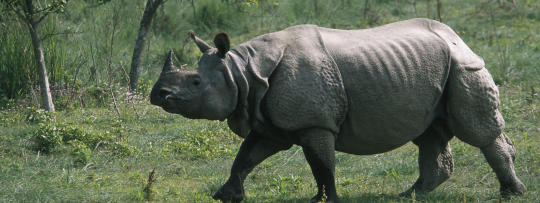
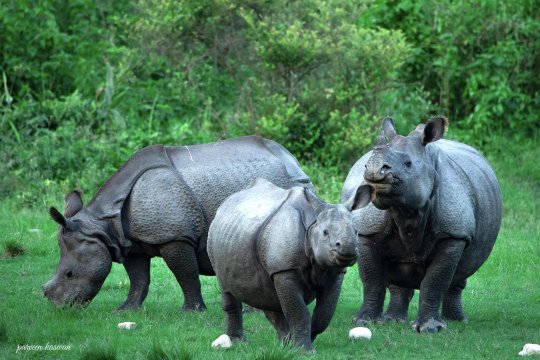
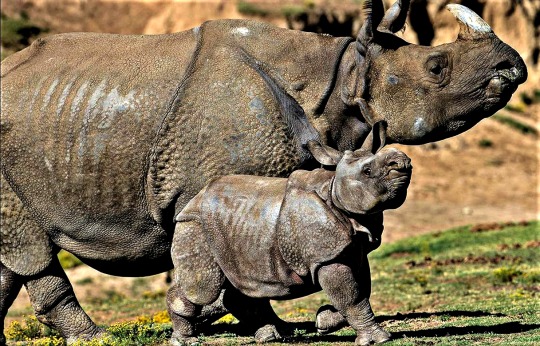
The Indian rhinoceros, also called the Indian rhino, greater one-horned rhinoceros or great Indian rhinoceros, is a rhinoceros species native to the Indian subcontinent where they can be found in a handful of national parks throughout the countries of India and Nepal. The Indian rhino alongside its close relative the Javan rhino make up the genus rhinoceros. Unlike most other species of modern rhino which are typically solitary animals, the Indian rhino can often be found living in social groups of upwards of 6 individuals typically consisting of mothers and there calves as well as subadults, said groups are occasionally accompanied by a bull but as they grow older males grow more solitary in nature. They typically inhabit grasslands, open dry forest, and riverine woodlands where they feed upon grasses, roots, leaves, branches, fruits, and submerged and floating aquatic plants. Because of there size indian rhinos have few natural predators except for tigers and mugger crocodiles which occasionally prey upon young, elderly, or infirm rhinos. Males are typically larger than females standing at upwards of 6ft tall at the shoulder, 12ft in length, and 4,800lbs in weight compared to females at 5ft tall at the shoulder, 11ft in length, and 3,500lbs in weight. This makes the Indian rhino the second largest living rhino species behind the white rhino, and also the second largest land animal in asian behind the asian elephant. These rhinos have a thick grey-brown skin with pinkish skin folds and one horn on their snout. Their upper legs and shoulders are covered in wart-like bumps. They have very little body hair, aside from eyelashes, ear fringes and tail brush. Adult males sport huge armored neck folds. After a 15-16 month pregnancy mother Indian rhinos will typically give birth to a single calf, which will remain by there mothers side for at least 2 years. Females reach sexual maturity sooner than males at around 4 years compared to males a 5 years of age. Under ideal conditions an Indian rhino may live upwards of 40 years.
#pleistocene#extant#living#indian#rhino#rhinoceros#mammal#one#horned#unicorn#horn#great#pleistocene pride
5 notes
·
View notes
Text
Indian #Rhinoceros are in trouble in #India their range in #Assam is earmarked for #palmoil #deforestation. Fight for them in the supermarket and #Boycottpalmoil #Boycott4Wildlife via @palmoildetect
#palm oil#rhinoceros#india#assam#deforestation#boycottpalmoil#boycott4wildlife#animalrights#161#1312#econotego#ecology#ausgov#politas#auspol#tasgov#taspol#australia#fuck neoliberals#neoliberal capitalism#anthony albanese#albanese government#class war#animals#animal#environmental activism#environmental#environment#enviroment art#environmetalists
1 note
·
View note
Text
Wild Wonders: Exploring the Breathtaking Wildlife Sanctuaries of India
1. Kaziranga National Park – A Haven for Rhinos:
Nestled in the northeastern state of Assam, Kaziranga National Park stands as a symbol of conservation success. Home to the Indian one-horned rhinoceros, Kaziranga’s sprawling grasslands and water bodies also host a vibrant array of wildlife, including elephants, tigers, and various bird species. Explore the wonders of this UNESCO World Heritage Site, where every moment is an encounter with the untamed.
Established in 1905, Kaziranga has emerged as a symbol of successful wildlife conservation, particularly for the Indian rhinoceros (Rhinoceros unicornis). It boasts the highest population density of this species in the world, with over two-thirds of the global population residing within its boundaries. This iconic park is not only a sanctuary for rhinos but also serves as a sanctuary for numerous other species, including tigers, elephants, wild water buffalo, and a myriad of bird species.
The park’s landscape is a mosaic of grasslands, wetlands, and dense forests, crisscrossed by the mighty Brahmaputra River and its tributaries. This diverse ecosystem provides a perfect habitat for a plethora of wildlife. Kaziranga is renowned for its rich avifauna, with over 500 species of birds, including migratory ones like the bar-headed goose and the greater adjutant stork, making it a birdwatcher’s paradise.
One of the most enchanting aspects of Kaziranga is its exhilarating safaris, offering visitors the opportunity to witness wildlife up close in their natural habitat. Jeep safaris and elephant rides are popular ways to explore the park, allowing visitors to traverse through its grasslands and dense forests, catching glimpses of rhinos, tigers, herds of elephants, and a myriad of other fascinating creatures.
However, Kaziranga’s success story is not without its challenges. The park faces persistent threats from poaching, habitat loss due to human encroachment, and natural calamities like floods. Despite these challenges, the dedicated efforts of park authorities, conservationists, and local communities have ensured the continued survival and thriving of its precious inhabitants.
In recent years, Kaziranga has also emerged as a pioneer in innovative conservation practices. Community-based initiatives, eco-tourism ventures, and collaborations with international organizations have played a pivotal role in safeguarding the park’s biodiversity while promoting sustainable development in the region.

2. Ranthambhore National Park – Where Tigers Roam Free:
In the heart of Rajasthan lies Ranthambhore National Park, a realm where the majestic Bengal tiger reigns supreme. The park’s historic backdrop, with the ancient Ranthambhore Fort looming over the landscape, adds an extra layer of charm to the wildlife experience. Venture into the wild on a safari, and you might just witness the regal tigers in their natural habitat.
Ranthambore’s history is as rich and vibrant as its landscapes. Once a hunting ground for Maharajas of Jaipur, it was declared a wildlife sanctuary in 1955 and later gained the status of a national park in 1980. The park’s topography is a blend of dry deciduous forests, meadows, lakes, and rugged hills, creating a perfect habitat for a myriad of species, including the critically endangered Bengal tiger.
The park’s crown jewel is undoubtedly the Bengal tiger, and Ranthambore boasts a healthy population of these magnificent predators. Visitors to the park are often treated to the awe-inspiring sight of a tiger gracefully navigating its territory or lounging beneath the shade of ancient trees. The park’s well-maintained network of trails and watchtowers offers ample opportunities for wildlife enthusiasts and photographers to observe these majestic creatures in their natural habitat.
Beyond the iconic tigers, Ranthambore is home to a diverse array of wildlife. Leopards, sloth bears, wild boars, and spotted deer roam freely amidst the dense foliage, while crocodiles bask in the sun along the park’s tranquil lakes. The avian population is equally impressive, with over 300 species of birds, including the endangered Indian eagle-owl and the vibrant painted stork, making Ranthambore their home.
Apart from its remarkable wildlife, Ranthambore is steeped in history and culture. The park’s boundaries encompass the majestic Ranthambore Fort, a UNESCO World Heritage Site dating back to the 10th century. This ancient fortress stands as a silent sentinel amidst the wilderness, offering visitors a glimpse into Rajasthan’s royal past and commanding panoramic views of the surrounding landscapes.
Conservation lies at the heart of Ranthambore’s ethos, with dedicated efforts aimed at preserving its delicate ecosystem and ensuring the continued survival of its iconic inhabitants. Sustainable tourism practices, community involvement, and scientific research form the cornerstone of conservation initiatives within the park, ensuring that future generations can continue to marvel at its natural wonders.

3. Periyar Wildlife Sanctuary – A Tropical Paradise:
Hidden in the Western Ghats of Kerala, the Periyar Wildlife Sanctuary is a tropical haven for wildlife enthusiasts. The shimmering Periyar Lake adds a scenic touch to the lush surroundings, creating a picturesque setting for observing elephants, sambar deer, and a myriad of bird species. Take a boat safari to explore the sanctuary from a unique perspective.
The sanctuary takes its name from the Periyar River, which meanders through its verdant forests, adding to the picturesque charm of the surroundings. Established in 1950, it was declared a tiger reserve in 1978, aiming to protect the majestic Bengal tiger and its natural habitat. However, the sanctuary is not just about tigers; it is home to a diverse array of flora and fauna that thrive in its varied ecosystems.
One of the highlights of Periyar Wildlife Sanctuary is its dense evergreen and moist deciduous forests, which provide shelter to a remarkable variety of wildlife. Visitors can embark on guided safaris or boat cruises along the Periyar Lake, offering opportunities to spot elephants, sambar deer, wild boar, langurs, and an impressive array of bird species, including the vibrant Malabar pied hornbill and the elusive Nilgiri wood pigeon.
For those seeking a more immersive experience, trekking trails wind through the sanctuary, leading adventurers deep into the heart of the forest. The trails offer a chance to witness the serene beauty of the surroundings up close, with encounters with wildlife adding an element of excitement to the journey.
Beyond its ecological significance, Periyar Wildlife Sanctuary also holds cultural importance. The indigenous tribal communities, such as the Mannans, Uralis, and Malampandarams, have inhabited these forests for centuries, coexisting harmoniously with nature. Visitors can learn about their traditional way of life and cultural practices through guided tours and interactions, gaining insight into the symbiotic relationship between humans and the environment.
Moreover, the sanctuary is a hub for ecotourism initiatives aimed at promoting sustainable practices and conservation efforts. Visitors can participate in activities such as nature walks, bamboo rafting, and spice plantation tours, gaining a deeper understanding of the region’s biodiversity and the importance of preserving it for future generations.

4. Jim Corbett National Park – India’s Oldest Tiger Reserve:
Established in 1936, Jim Corbett National Park in Uttarakhand holds the distinction of being India’s oldest tiger reserve. The park’s diverse landscapes, ranging from grasslands to dense forests, provide a habitat for tigers, leopards, and a rich variety of birdlife. Immerse yourself in the thrill of the jungle on an adventurous safari.
Jim Corbett National Park is not only famed for its tiger population but also for its rich diversity of flora and fauna. It encompasses a variety of habitats, including dense forests, grasslands, rivers, and marshy depressions, providing a suitable environment for a myriad of species. Apart from tigers, the park is home to leopards, elephants, sloth bears, deer species like sambar and chital, along with over 600 species of birds, making it a paradise for birdwatchers.
One of the best ways to explore the wilderness of Jim Corbett National Park is through safari tours. The park offers various safari options, including jeep safaris, elephant safaris, and canter safaris, allowing visitors to venture deep into the heart of the forest under the guidance of experienced naturalists. These safaris offer a chance to witness wildlife in their natural habitat, from elusive tigers prowling through the undergrowth to vibrant bird species flitting among the trees.

5. Bandipur National Park – Where Wilderness Meets Serenity:
Karnataka’s Bandipur National Park is a harmonious blend of wilderness and tranquility. As you traverse the park’s winding roads, encounter herds of wild elephants, spotted deer, and even the elusive Indian leopard. The park’s commitment to conservation and eco-tourism ensures an immersive and responsible wildlife experience.
A Sanctuary for Wildlife: Bandipur National Park, along with the neighboring reserves of Mudumalai, Wayanad, and Nagarhole, forms the Nilgiri Biosphere Reserve, one of India’s most significant protected areas for wildlife. The park’s dense forests and diverse ecosystems provide a safe haven for numerous species, including the majestic Bengal tiger, Indian elephant, sloth bear, Indian bison (gaur), and elusive leopards. Its avian population is equally rich, with over 200 species of birds gracing the skies, including the vibrant Malabar trogon and the iconic Indian roller.
A Tapestry of Flora: Encompassing an area of approximately 874 square kilometers, Bandipur is adorned with a rich tapestry of flora, ranging from moist deciduous forests to tropical mixed forests. The landscape transitions gracefully from open grassy meadows to dense thickets, creating a kaleidoscope of habitats for its inhabitants. Towering teak, sandalwood, rosewood, and giant bamboos dominate the canopy, while the forest floor is carpeted with a myriad of shrubs, climbers, and wildflowers, adding to the park’s ethereal charm.
A Paradise for Eco-Tourism: Bandipur National Park beckons nature enthusiasts and wildlife aficionados from around the globe to immerse themselves in its pristine beauty and unparalleled biodiversity. Guided safaris through the park offer visitors a chance to witness the splendor of its wildlife in their natural habitat. Whether it’s a thrilling jeep safari at dawn, a tranquil elephant safari meandering through the wilderness, or a leisurely nature walk along designated trails, every moment spent in Bandipur is an enchanting encounter with nature’s wonders.
Preserving a Legacy: Established in 1974 as a tiger reserve under Project Tiger, Bandipur has been at the forefront of wildlife conservation efforts in India. Its success story is a testament to the dedication of park authorities, conservationists, and local communities in safeguarding its precious biodiversity. Through proactive measures such as habitat restoration, anti-poaching initiatives, and community-based conservation programs, Bandipur continues to thrive as a sanctuary for endangered species and a beacon of hope for future generations.

Conclusion:
India’s wildlife sanctuaries are not just protected areas; they are living, breathing ecosystems that showcase the country’s commitment to preserving its natural heritage. From the northern reaches of the Himalayas to the southern tip of the Western Ghats, each sanctuary tells a unique tale of biodiversity and conservation. So, gear up for an adventure, and let the wild wonders of India’s wildlife sanctuaries captivate your senses, leaving you with memories of encounters with the untamed beauty of the subcontinent.
#cottage#cottagecore#landsccape#paradise#nature#adventure#explore#travel#travelling#photography#aesthetic#cottage garden#country cottage#cottage witch#flowercore#flowers#dark acadamia aesthetic#light academic aesthetic#photographers on tumblr#mountains#illustration#artists on tumblr#curators on tumblr#landscape#chaotic academia#cozycore#lovecore#inspiration#motivation#naturecore
0 notes